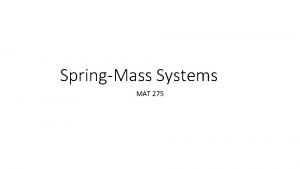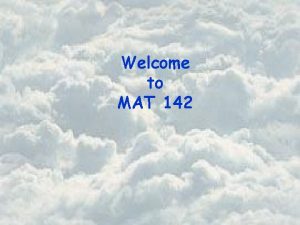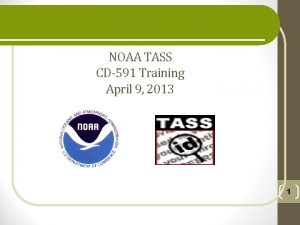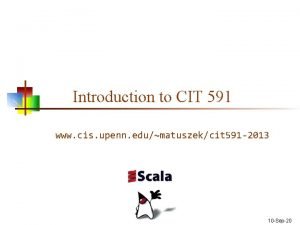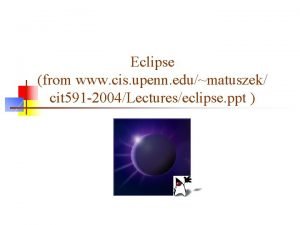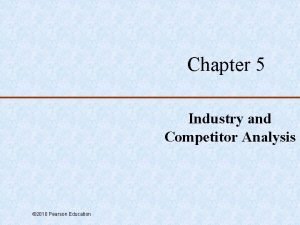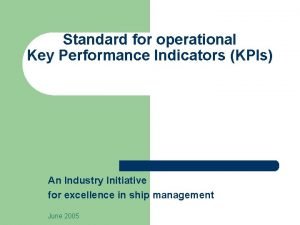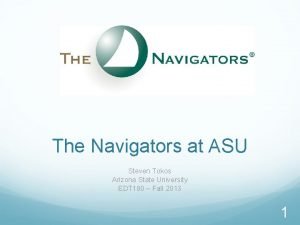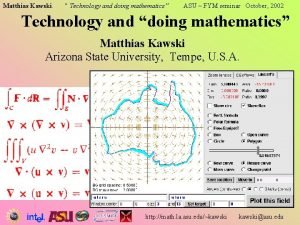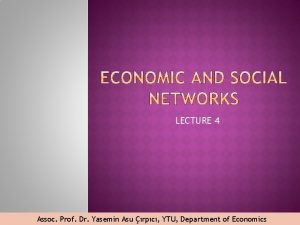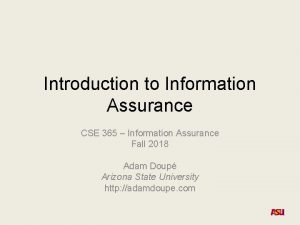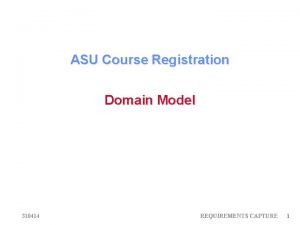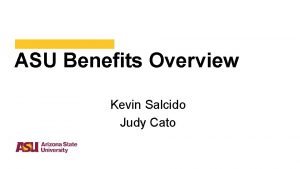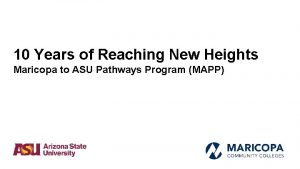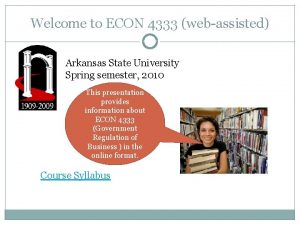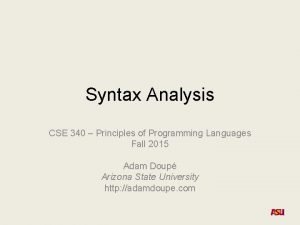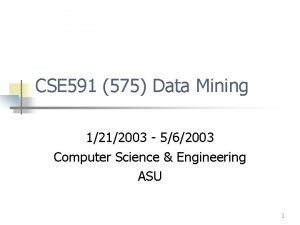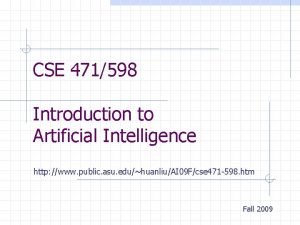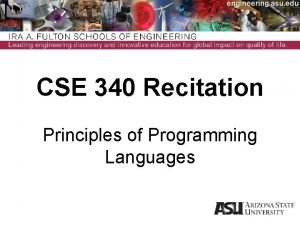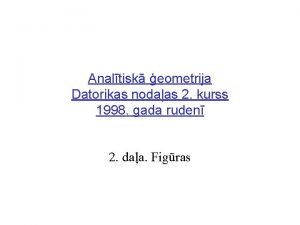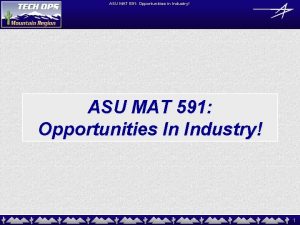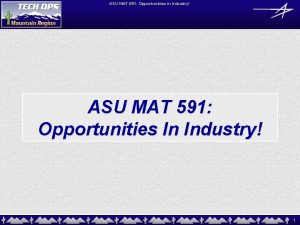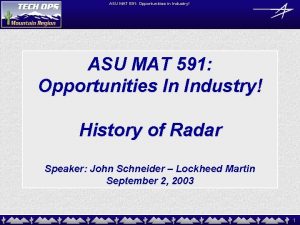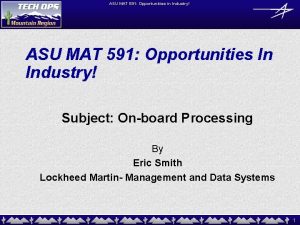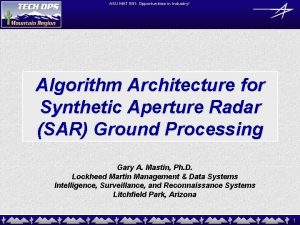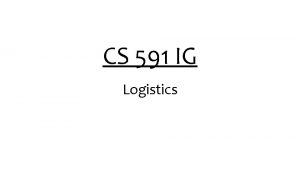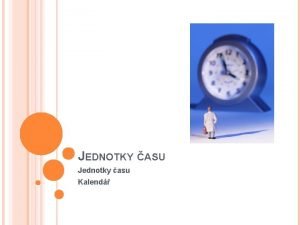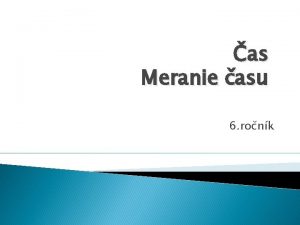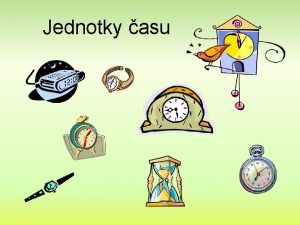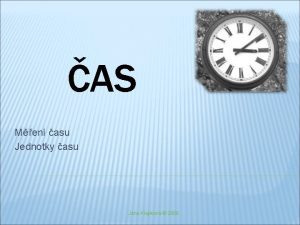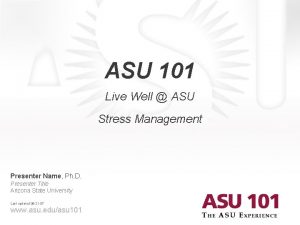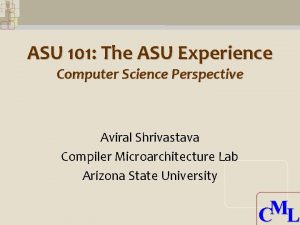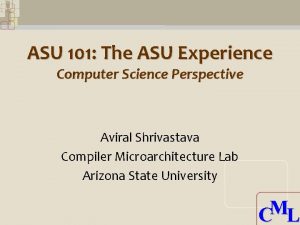ASU MAT 591 Opportunities in Industry High Performance






























- Slides: 30

ASU MAT 591: Opportunities in Industry High Performance Arithmetic John Kerl Lockheed Martin Management & Data Systems Intelligence, Surveillance, and Reconnaissance Systems Litchfield Park, Arizona October 18, 2004 john dot r dot kerl at lmco dot com kerl at mathpost dot asu dot edu 1

ASU MAT 591: Opportunities in Industry Volumes of data require automation Abstract Human Design How the … ? ? Concrete Machine Implementation 0101 0011 0000 0101 1000 0000 1101 1000 1001 0000 1001 1110 0101 1110 1011 0101 0011 1110 1100 1000 0111 0010 1011 1101 0111 0100 0001 1101 0101 1000 1001 0000 1000 0000 1101 0100 0011 1000 0111 1000 0001 1011 0100 0001 1100 0101 0010 1101 0000 1101 0110 1000 2

Isn’t the rest merely implementation details? ASU MAT 591: Opportunities in Industry Recent talks in this series have presented some high-level designs for compute-intensive problems l Implementation details are where engineers spend much of their time, hence much of the company’s resources l It is important that high-level designers be aware of low-level constraints, and that low-level implementers be aware of the big picture l Implementation constraints affect design l 3

General-purpose tools don’t always suffice ASU MAT 591: Opportunities in Industry Computer algebra systems such as MATLAB, Mathematica, etc. , provide abstract-looking syntax l Excellent for prototyping, but don’t provide adequate performance for demanding applications. l We have competitors, and so do our customers. Everyone wants to process more data, in less time, at more MIPS per watt. l We use common off-the-shelf (COTS) technology when appropriate l When standard parts aren’t fast enough, we build our own l We do what we know, partner for what we don’t l We re-use past efforts (and design for re-use) to reduce risk and cost l 4

Hardware acceleration is everywhere ASU MAT 591: Opportunities in Industry HW/SW choices presented here don’t just apply to SAR/DSP: l Other DSP applications l Adaptive control l Telecommunications l Cryptography: Large-modular (RSA), finite-field (AES), elliptic curves l Error-control coding l Anywhere real-time computation is needed 5

ASU MAT 591: Opportunities in Industry Hierarchy of detail It all has to work, even SAR algorithm Chains (deskew, autofocus, …) though no one person understands it all Primitives (FFT, IPF, …) Arithmetic (+, -, ·) Logic gates (NAND, XOR, …) Key to success: Resistors, capacitors, transistors Modular design Materials at all levels Quantum mechanics 6

ASU MAT 591: Opportunities in Industry Disciplines Systems engineering l Software engineering l Electrical engineering l (Mechanical engineering*) l (Chemical engineering) l (Materials-science engineering*) l Program management: The difference between a good job and a great job; the difference between an also-ran and a winning organization l 7

ASU MAT 591: Opportunities in Industry Useful skills for success in industry Interdisciplinary education l Writing and speaking skills are always needed l Programming skills are vital for almost any technical job. You must learn at least one of C, FORTRAN, MATLAB, Perl, etc. l Can you perform some basic computational tasks, both on paper and using automation: numerical estimation of a derivative, integration using Simpson’s rule, Lagrange interpolation, Taylor-series approximation, making plots, etc. ? If not, learn how. l Undergraduate numerical analysis and computer arithmetic l Digital design: CSE 330, various EEE courses l 8

ASU MAT 591: Opportunities in Industry Discretization Continuous analog waveform … … sampled in discrete time … … with discrete amplitudes 9

Fundamental arithmetic operations for DSP ASU MAT 591: Opportunities in Industry Addition, subtraction and multiplication l Division not so much. Multiply by reciprocals of constants when necessary. l A common operation is multiply and accumulate (MAC): sum of products l Number formats: signed or unsigned fixed-point (integers are just a special case); floating point. l Today we’ll discuss addition of unsigned integers. l In digital logic, high voltage (5. 0 V, 3. 3 V, 1. 8 V, …) represents a one l Low voltage (0 V) represents a zero l Arithmetic is done in binary (base 2) l 10

ASU MAT 591: Opportunities in Industry Integers and integer addition l l Binary integers: base 2, not 10. E. g. 01011 = 8 + 2 + 1 = 11 N bits: MSB is 2 N-1, LSB is 20 = 1 5 +3 -----8 l l 0101 + 0011 -----1000 Addition is just like in elementary school “ 1 + 1 is 0, carry the 1 … ” Column sums Carry-in, carry-out 11

ASU MAT 591: Opportunities in Industry Digital logic gates We take these as our starting point (lowest level in the design hierarchy) Name AND: Truth table 0 1 0 0 0 1 OR: 0 1 0 0 1 1 XOR: NOT: 0 1 0 1 1 1 0 Schematic symbol De. Morgan’s Laws: = = 12

ASU MAT 591: Opportunities in Industry Digital logic gates (cont’d) Each of these is composed of resistors, capacitors, diodes, transistors and wires, each of which is built to have a simple mathematical model l Put it in a box and label it with a schematic symbol (modular design) l Vcc 13

ASU MAT 591: Opportunities in Industry Digital logic gates (cont’d) Conductors have overlapping outer bands; outer electrons are free to flow l Electron charges are quantized, but (at fabrication scales in use today!) we can still model them as a fluid l Current flows, but in digital logic we think of voltage as carrying information l Power-plane voltage is high (1); ground-plane voltage is low (0) l A NOT gate drives out a low voltage when input voltage is high, and vice versa. Similarly for the other gates. l 14

ASU MAT 591: Opportunities in Industry Integer addition using logic circuits l 1 -bit half adder: 0 +0 -----00 0 +1 -----01 Sum Carry-out 1 +0 -----01 S 1 +1 -----10 A B O Hide the details in a box: A B H S O Notice: l Column sum is XOR of inputs (sum mod 2) l Carry-out is 1 if both inputs are 1 (AND) 15

Integer addition using logic circuits (cont’d) ASU MAT 591: Opportunities in Industry l l 1 -bit full adder: A + B + carry-in gives column sum and carry-out S A B I O A Hide the details in a box: B I F S O 16

ASU MAT 591: Opportunities in Industry N-bit full adder (4 -bit example) 0101 + 0010 = 0111 i. e. 5 + 2 = 7 (1’s here are marked in red) A 0=1 B 0=0 A 1=0 S 0=1 Put this all in a box and call it: 4 4 + 4 S 1=1 B 1=1 A 2=1 S 2=1 B 2=0 A 3=0 B 3=0 S 3=0 (Remember: this is nothing more than the elementary-school algorithm. ) 17

ASU MAT 591: Opportunities in Industry Timing (the heart of digital design) Everything up to now was static l Now let bit B 0 change from 0 (low voltage) to 1 (high voltage) l The low-to-high wave front has its own rise time: l A 0=1 Sample the voltage here (another continuous analog waveform) and plot with respect to time: B 0=0 Furthermore, it takes some propagation time for the wave fronts to travel from the B 0 input to the S 0 -S 3 outputs (all of which change in this example), then stabilize (remember forced damped oscillator from ODEs? ) to their new values l Values during that time are not mathematically correct l 18

ASU MAT 591: Opportunities in Industry Clocking Just as with the signal under analysis (for which these circuits are built), we sample the voltages at discrete times, with discrete amplitudes (but only two levels here: high and low) l There is an oscillating (sinusoidal or square) signal called the clock fed throughout the chip. Clock frequency in MHz or GHz. l Electronic devices (made of logic gates) called registers retain whatever value is present at, say, the rising clock edge, and drive that out until the next rising edge Sample l points Wire signal (register input) Clock signal Registered signal (register output) 19

ASU MAT 591: Opportunities in Industry Registers The amount of combinational logic between registers determines the pipeline depth. l Maximum depth constrains clock speed, or vice versa. l In order to meet timing, sometimes logic must be split across registers, decreasing depth but increasing latency (e. g. 1 clock for an add, 3 for a multiply). l Input 4 Output 4 4 + 4 4 Clock 4 20

ASU MAT 591: Opportunities in Industry Registers and wires l To a first approximation, digital logic consists of: – The clock (distributed throughout a chip) – Registers, where voltages can change only at e. g. rising clock edge – Wires (“combinational logic”), where voltages can change at any time The clock signal must be clean (no spurious edges) l Register inputs must not be near half-value at sampling time l The deepest logic in the circuit limits the clock speed l Clock frequency can’t be too high (and/or logic too deep), else wire signals will be sampled before they are stabilized to their new values l This is why engineers have to work so hard to increase clock frequency l 21

ASU MAT 591: Opportunities in Industry Faster, faster Increase the clock frequency, i. e. shorten the clock period l Requires shortening path length l Requires finer fabrication techniques (130 nm, 90 nm, …) l Keeps electrical and materials-science engineers employed l 22

ASU MAT 591: Opportunities in Industry Sequential processors Machine instructions are just integers stored in memory l Stored-program concept: instructions are data l Various bits in an instruction word specify arithmetic and/or I/O operations l Arithmetic and logic unit (ALU) has various arithmetic blocks l Only one result is done at a time Instruction word l Sequential processing 32 l 32 32 … Operation select (+, -, ·, <, etc. ) 32 23

ASU MAT 591: Opportunities in Industry Sequential processors (cont’d) Everyone knows about Pentiums l Embedded processors: Power. PC, ARM, etc. l Programmable via an instruction set l Higher-level languages (C/C++, FORTRAN, MATLAB, . . . ), largely portable l Compilers are highly non-trivial (keeping computer scientists employed) l Many MB (GB? ) of RAM, plus GB of disk, permit quite large instruction space, stack space, deep recursion, many function arguments, etc. l The programmer has a lot of freedom l 24

ASU MAT 591: Opportunities in Industry Sequential processors (cont’d) Hardware design is fixed l Mercifully, you don’t need to muck with the hardware in order to write programs l Intel et al. invest time and resources into making a reliable, functionally correct processor l Customers don’t need to be convinced that such chips function correctly l Approximately one instruction per clock cycle l Key point: Quicker to write, slower to run l 25

ASU MAT 591: Opportunities in Industry Custom parallel processing We want to do more than one thing at a time l The hardware design is our own, so we can do what we want l This takes time and resources to implement l VHDL/Verilog are fundamentally different from C/FORTRAN l But we don’t want to make everything custom: l CPUs are highly non-trivial l Expense of design and verification l Customer might doubt the result will be bug-free (“risk reduction”) l Focus on our core competencies l CPUs are still nice for setup and control l Key point: Slower to write, quicker to run. l 26

ASU MAT 591: Opportunities in Industry Custom parallel processing (cont’d) Find those steps in the algorithm most in need of acceleration, and most amenable to it. Create custom circuitry for those things only: hardware-software co-design. l How much programmability should we implement? l – – At least, vector lengths and coefficients Microcode? Simple instruction set? Include a third-party CPU core (e. g. ARM)? 27

ASU MAT 591: Opportunities in Industry Custom parallel processing (cont’d) Signal processing primitive: FFT radix-2 butterfly. A ± w · B, with A, B, and w complex numbers, w on the unit circle (ei 2πk/N) l ei 2πk/N might be computed/interpolated using custom circuitry l Depending on the amount of parallelism, maybe several output samples per clock l Logic depth and clock determine number of registers (latency) l The result can far outperform a comparably clocked sequential processor l + DAG Input buffers DAG x Trig - DAG Output DAG buffers Complex math (really 4 multipliers, 3 adders, 3 subtracters) 28

ASU MAT 591: Opportunities in Industry References Feynman, Feynman Lectures on Computation l Hennessey and Patterson, Computer Organization and Design l Horowitz and Hill, The Art of Electronics l Knuth, The Art of Computer Programming: Seminumerical Algorithms (vol. 2) l Press et al. , Numerical Recipes l 29

ASU MAT 591: Opportunities in Industry Thanks for attending! 30
 Scott surgent asu
Scott surgent asu Mat 142
Mat 142 Noaa cac card
Noaa cac card Cit 591 upenn
Cit 591 upenn Cit 591 introduction to software development
Cit 591 introduction to software development Pearson education competitors
Pearson education competitors Key performance indicators for shipping industry
Key performance indicators for shipping industry Performance management vs performance appraisal
Performance management vs performance appraisal Disadvantages of bell curve in performance appraisal
Disadvantages of bell curve in performance appraisal Jcids manual
Jcids manual Academic status report asu
Academic status report asu Asu tma
Asu tma Asu color palette
Asu color palette Matthias kawski
Matthias kawski Yasemin asu çırpıcı
Yasemin asu çırpıcı Cse 365 asu
Cse 365 asu Asu 2016 14
Asu 2016 14 Phy 131 asu
Phy 131 asu Asu course catalogue
Asu course catalogue Kevin salcido
Kevin salcido Asu mapps
Asu mapps Blackboard astate
Blackboard astate Asu cse 340
Asu cse 340 Brandguide asu
Brandguide asu Asu prep parent portal
Asu prep parent portal Cse 545 asu github
Cse 545 asu github Asu cse 575
Asu cse 575 Cse 471 asu
Cse 471 asu Cse 471 asu
Cse 471 asu Cse 340 asu
Cse 340 asu Taisnes vienādojums asu nogriežņos
Taisnes vienādojums asu nogriežņos
